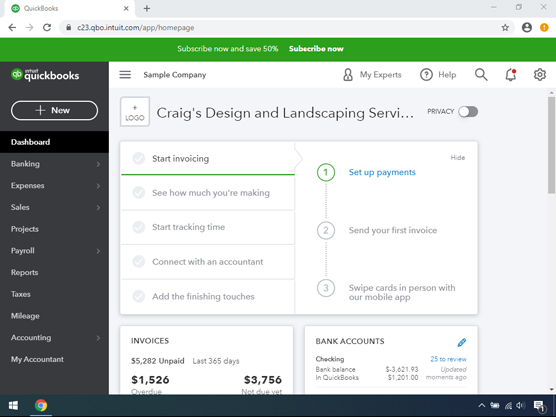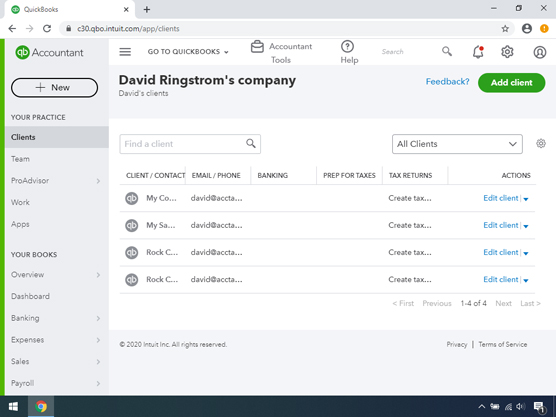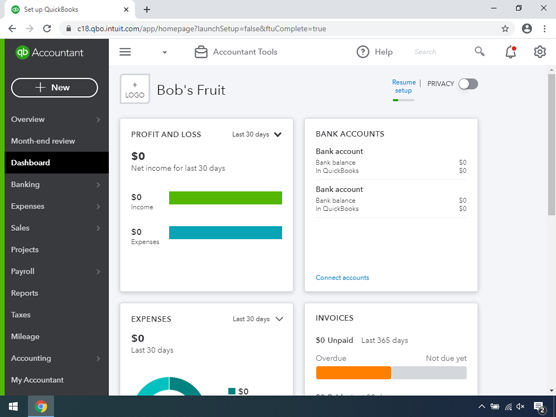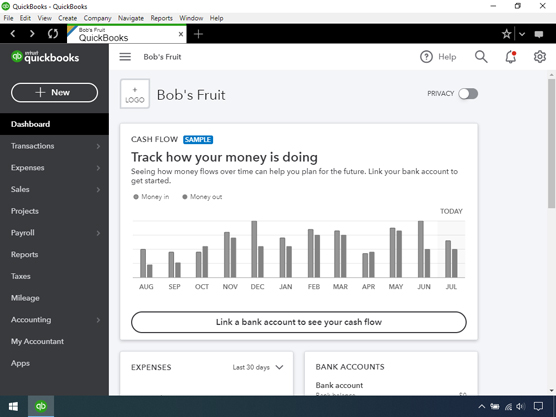QuickBooks Online (QBO) is the cloud-based product for end users who need to perform typical accounting tasks. QBO is based on the same principles as the QuickBooks Desktop product—that is, it uses lists to, for example, manage customers and vendors, and it includes transactions similar to the ones found in the QuickBooks Desktop product. But, QBO is not simply a “rewrite” of the QuickBooks Desktop product for the web. It was designed and developed as a new product, optimized for web-based usage.
QuickBooks Online Accountant (QBOA) is the cloud-based portal that accountants use to access client QBO companies, work in them, and communicate with clients. QBOA also includes a QBO company in its Your Books section that accountants can use to track the accounting of their own businesses.
How QBO and QBOA interfaces compare
QBO and QBOA were initially written and optimized to be used in the major web browsers—Chrome, Firefox, Safari, Microsoft Edge, and Internet Explorer. Later, Intuit added QBO apps that you can use to work in QBO on iOS and Android mobile devices.Intuit also offers a desktop version of QBO, referred to in this book as, cleverly, QBO Desktop. This version is not a mobile app (it won’t work on phones and isn’t available in the Google Play Store or the Apple App Store) but it will work on any Mac or Windows computer. This includes “portable” computers, like laptops and tablets running Windows or Mac OS, making it somewhat mobile. It also is not the QuickBooks Desktop product, which is not a cloud-based product.
Explore what QBO and QBOA look like in a browser. The next section gives an overview of what the QBO Desktop edition looks like, as well as detailing some of the things you can do in the iOS and Android mobile app versions of QBO.
In a browser, an open company in QBO looks similar to the one shown below. The Navigation bar runs down the left side of the screen. If you’ve been a QuickBooks Desktop user and you’ve used the Left Icon Bar in that product, you might find the Navigation bar a familiar tool. The Left Icon Bar and the Navigation bar work the same way; you click a link in either of them to navigate to a portion of the program.
 An open company in QBO
An open company in QBOClicking the three-striped button beside the QuickBooks logo above the Navigation bar enables you to collapse the Navigation bar to view just the icons (and clicking it again expands the Navigation bar back to the view shown). When you collapse the Navigation bar, you have more screen real estate to view the right side of the QBO interface.
At the top of the screen, you see tools that help QBO users create transactions, search for existing transactions, and view settings for the QBO company.
The following figure shows what an accountant sees immediately upon logging into QBOA. The Navigation bar changes to support an accountant’s needs.
 The first view an accountant has when opening QBOA
The first view an accountant has when opening QBOAWhen an accountant opens a client’s company from within QBOA (see the following figure), the interface resembles what a client sees, with some minor differences. Compare the two interfaces. First, you know you’re using QBOA because the top of the Navigation pane shows QB Accountant. Second, the Accountant Tools menu (the briefcase icon) displays tools not found in QBO that help accountants manage client companies.
 An open company in QBOA
An open company in QBOAEven though an open company looks a bit different depending on whether you open it using QBO or QBOA, the basic functionality doesn’t really change, other than accountants have more options than end users have.
QBO Desktop and QBO Mobile
You can work with QBO and QBOA without using a browser; you can use QBO Desktop or you can use the iOS or Android apps.QBO Desktop
If you prefer, you can work with QBO using QBO Desktop; it’s purported to run faster than QBO in your browser, but we’ll let you judge for yourself. To download QBO Desktop, use your browser to navigate to the QBO sign-in page. On the page that appears, you’ll see a Free Download button; click it and follow the onscreen instructions to download and install QBO Desktop.Both Windows and Mac users can use the same QBO Desktop app; what you download from the QBO sign-in page works on both platforms. Ingenious, don’t you think?
The word “app” has become a buzzword and is often used when it probably shouldn’t be. In this article, we’re using the word “app” only when we refer to the mobile versions of QBO and QBOA that are available for download from the Google Play Store or the Apple App Store.
In many places online, you’ll find references to a QBO Windows app — and, at the time we wrote this, there was no Windows app per se. There is QBO Desktop, which allows Windows users (except Windows Phone users) to use QBO while being mobile — on, for example, laptops and tablets. But QBO Desktop is not available from any of the “mobile device” stores (Google Play or Apple App) and, therefore, we’re not calling it an app.
This figure shows QBO Desktop with a QBO company open. QBO while working in QBO Desktop
QBO while working in QBO DesktopThis figure shows QBOA just after opening it in QBO Desktop (but before opening any client company).
 QBOA while working in QBO Desktop
QBOA while working in QBO DesktopQBOA users have the same additional options in QBO Desktop that they have in a browser. The menus at the top of the screen are the biggest visual difference between QBO and QBOA in QBO Desktop and QBO and QBOA in a browser. If you’ve been a QuickBooks Desktop product user, you know that you can use the menus to navigate. Under the hood, QBO Desktop offers some options that you won’t find readily available in a browser, such as the ability to work in multiple windows.
QBO mobile apps
At no additional cost to you, mobile apps are also available for iPhones, iPads, and Android devices. The iOS and Android apps are optimized for touch interaction and on-the-go workflows like customer management, invoicing, estimates, and signatures. You also can use the mobile apps to track the status of invoices, take payments, reconcile bank accounts, capture expenses, and check reports. And, you’ll find Pinch and Zoom functionality in the mobile apps and in browsers on mobile devices.You can get the mobile apps here. In addition to using the QBO mobile apps for iOS and Android, you also can access the QBO sign-in page and your QBO account from your mobile device’s browser at Intuit.
New features are added often to the mobile apps. For example, you can customize invoice templates from the browser-based QBO and from QBO Desktop. You can customize templates from mobile devices but not using mobile apps; instead, use the browser-based QBO on your mobile device.
Be aware that the browser-based version of QBO and QBOA has additional functionality and keyboard shortcuts geared towards more in-depth business accounting tasks.
So, take your choice; you’re not limited: Work in a browser, work in QBO Desktop, or work in a mobile app, depending on your needs at the moment.




